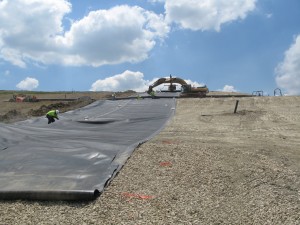 Over the years, landfills have drastically changed. They went from dump sites, which left the environment unprotected, to state of the art facilities designed to keep the environment and its neighbors safe and clean.
Over the years, landfills have drastically changed. They went from dump sites, which left the environment unprotected, to state of the art facilities designed to keep the environment and its neighbors safe and clean.
The landfill is divided into cells, or designated areas where the land will be prepared for trash disposal. When it is time to begin preparing for cell construction, crews excavate an area approximately 20-25 acres wide and various depths depending on aquifers in the land.
The cell is now ready for the first protective layer, three feet of re-compacted clay. The clay acts as a natural barrier between the trash the environment below. High-density polyethylene (number two plastic) is added preventing liquids from reaching the top of the clay liner.
A geocomposite layer is added to the cell acting as a cushion for sharp objects that may puncture other layers. Finally, sand, gravel or ground-up tires are spread to operate as a drainage layer to help filter the leachate into a series of pipes and pumps, which help transport the leachate to the local wastewater treatment plant for final treatment. Once these four layers cover the inside of the cell, a select layer called a “fluff” layer of garbage is placed on top. The “fluff” layer is typically residential trash and does not contain bulky items.
After a cell is filled to capacity, the same liner system is placed over top. By placing the liner system on both the top and bottom of the cell, it acts as giant garbage bag keeping all the trash contained to protect the environment.
Lining the landfill makes it sanitary for the environment as well as our neighbors. In addition, the liner system decreases possible odors from escaping the property.
About the author: Tyra Owens is a corporate communications intern at Rumpke.